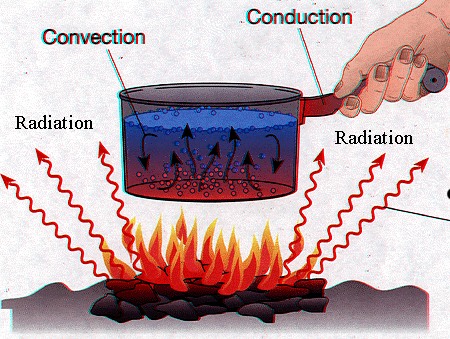Thermodynamics cont.
Heat Transfer
There are 3 ways in which a marine mammal can exchange heat with its environment:
Conduction, Convection, and Radiation.

http://www.aos.wisc.edu/~aalopez/aos101/wk5/heatrans.jpg
- Conduction: occurs because energy is passed on from one particle to another through direct contact (heat can't travel through vacuum by conduction). Heat is transferred because "the kinetic energy of thermal motion is transferred by molecular collision along the object" (or from one object to another if they are touching). In other words, when the fast moving molecules in a hot object/area bump into neighboring particles that are slower moving because they're cooler (remember that heat is basically just kinetic energy of particles, so hot = particles moving fast), kinetic energy is transferred to the cooler particles, heating them up & speeding them up; then these particles bump into their neighbors, transferring kinetic energy, and so on. (Giancoli 395).
- Convection: "is the process whereby
heat flows by the mass movement of molecules from one
place to another." It occurs in fluids (can't happen
in vacuum either), and involves the movement of many
particles over long distances (Giancoli 397).
This is the form of heat transfer by which marine
mammals lose most of their heat (in combination with
conduction): the thin layer of water they warm-up
around their bodies through conduction (called a
boundary layer) is constantly washed away by the
circulating water around them (which is cold), taking
away that heat & putting a new layer of cold water
around them (which they will need heat-up).
(Horstmann-Dehn, 2012)
- Radiation: Energy is transferred in
the form of electromagnetic waves (called radiation),
which can be of different wavelengths, including
visible light & infrared radiation (the latter is
mainly responsible for heating things up). No material
is needed for energy to be transferred in this way
because electromagnetic waves can travel through
vacuum (Giancoli 399). Every object that has energy
emits radiation, so in the same way that a sea lion
can get heat through radiation by basking in the sun,
it is also constantly radiating heat itself in the
form of infrared radiation. The rate at which
something radiates energy is proportional to its area
and to the fourth power of its temperature (in
Kelvin); this is called the Stefan-Boltzman Equation
(Giancoli 399).
The following video from TVOntario (1980), gives a great explanation/summary of how these three mechanisms of heat transfer work:
Back to Marine Mammals:
How do they prevent heat loss? Their main strategy is to prevent conduction (remember, that's how they lose heat by heating-up the boundary layer that is constantly washed away by convection) by insulating their body either with fur or with blubber, both of which have very low thermal conductivities (k).
What is thermal conductivity, you may ask? Its a constant that is characteristic of each material and that plays an important role in determining the rate of heat flow through it via conduction. Materials with low k are good insulators (reduce heat flow), and materials with high k are bad insulators (allow heat to flow easily).
This rate of heat flow also depends on the difference in temperature, the surface area, and the distance or thickness, according to Fourier's Law. So if an animal wants to reduce heat loss, it should have a thick layer of insulation, made of a material with a low k, and it should reduce its surface area to volume ratio, and this is indeed what marine mammals do.
(Horstmann-Dehn)


